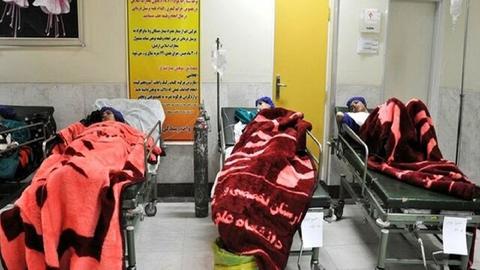Iran-HRM – The Noor School of Art in Qom was targeted by a chemical attack for the first time on November 30, 2023. Since Wednesday, March 1, 2023, these chemical attacks have been growing exponentially, with attacks spreading to 100 schools on Saturday, December 4, and to 100 cities on Sunday, March 5. On Monday, March 6, the attacks reached all parts of Iran, including many deprived areas that are hardly found on the map.
In these small cities, there aren’t even respiratory resuscitation facilities available for these students. Furthermore, these chemical attacks, which initially targeted girls’ schools, have now spread to boys’ schools, and at the time of this report’s publication, girls’ student dormitories have been subjected to chemical attacks. It’s important to note that these statistics only cover the period prior to the report’s publication.
Despite nearly 100 days passing since the beginning of these attacks, none of the attackers have been arrested, and the source of the poisoning remains unknown. This report aims to depict the alarming situation regarding the gases used in these attacks, as well as the clinical symptoms of this poisoning on students, which will have destructive long-term effects. Additionally, it highlights the authorities’ repression and prevention of these attacks from being reported by Iran’s security forces.
At present, the situation of students in Iran has reached an alarming point, and it is imperative that human rights organizations take immediate action to stop this crime.
Use of combined gases!! Ordinary individuals do not have access to these gases
In an interview with a local newspaper, Mohammad Reza Hashemian, a specialist in the intensive care unit (ICU) of Masih Daneshvari Hospital, stated on March 5, 2023, “The gas released is N2, or nitrogen, or N2O, which is an anesthesia gas. Some students reported smelling the odor of eggs when the gas was released, which is typical of gases containing sulfur. In recent days, students have also reported the smell of rotten tangerines or bleach. Each of these smells indicates a particular type of gas. But it appears that in these incidents, combined gases are being used for poisoning, and it is being used very tactically.”
He emphasizes that access to these gases is not possible for ordinary people. Although some gases are used for anesthesia or laparoscopy, they are not readily available to the public.
According to his statement, some reports indicate that people have experienced muscle numbness or temporary paralysis. In any case, the issue is severe and can lead to even more severe consequences, such as kidney and lung problems. “This matter should not be taken lightly. We are still at the beginning of this story. The source of this poisoning must be determined as soon as possible so that doctors can use its antidote and know which medicine to use to treat those who have been poisoned.”
The source of the poisoning is unknown
Hadi Abdullahi, an emergency physician at Tehran’s Fayaz-Bakhsh Hospital, states that “the general symptoms of this poisoning are similar to those of possible poisoning with an unknown substance, such as nausea, vomiting, headache, dizziness, and muscle cramps.” He explained that based on his experience during the war, this substance is inhaled and enters the body through the air and respiratory system, causing physical and respiratory symptoms. Additionally, the poisoning temporarily affects the brain and nervous system, as well as the digestive or dizziness and nausea centers.
“In regard to the recent poisoning, we still do not know the main substance and are only treating the students who have developed symptoms,”
He noted that, usually half an hour after the gas emission or exposure to an unpleasant smell, its symptoms become evident and gradually affect many people. In some cases, this may happen in less than a few minutes and continue to affect the brain and nervous system. “The complications that occur are usually temporary and last for two or three hours. However, since the origin of the gas used in these attacks is unknown, it is impossible to predict the long-term consequences or whether it may cause genetic mutations.”
He asserts that the gases being used are certainly not accessible to everyone.
According to expert doctors, the gas used in most of the attacks is a combination of arsenic and hydrogen, which is the basis of the chemical gas arsenic. A large amount of this gas is very deadly. But small amounts of this gas cause poisoning, dizziness, lethargy, etc. The effects of this gas on the body in the long run can lead to skin cancer and serious damage to the lungs, intestines, and liver.
Violent treatment of poisoned students by security agents
It is likely that government authorities in Iran have given specific instructions to all principals in Iran’s schools on how to deal with gas attacks in schools, as similar behavior has been observed among most of the principals. They have prevented the notification and arrival of emergency services and put students’ safety at risk.
Human Rights Monitoring has obtained dozens of examples, including the following:
- On March 6, 2023, the Boys’ High School of Khordad 14 First Period in Ilam was chemically attacked, which caused the students’ conditions to worsen. However, the principal and school officials frightened and silenced the students through bad behavior, warning them that they would be expelled if they reported the incident to anyone.
- On Monday, March 6, 2023, Shahid Naqadeh High School in West Azarbaijan province was chemically attacked. The school principal closed the doors and did not allow students to leave or anyone to enter, including ambulances to enter the school yard.
- On Monday, March 6, 2023, Farideh Miri High School in Babol was subjected to a chemical attack, causing many students to faint. However, when protesting families arrived, the police force arrested them and brought photographers from the local radio and television to show that everything was normal! The school principal had told the children not to go outside, claiming that the municipality was burning garbage. As a result, the children were kept in the gas-contaminated environment for an hour before an ambulance arrived.
- On March 6, 2023, there was a gas attack at the boys’ schools in Mahshahr. However, the school principal did not allow the students to leave and claimed that there was nothing wrong. Classes continued as usual, but after school, the children’s faces were all red, their eyes were full of tears, and they were continuously coughing.
Also, the journalist who first published the news of the poisoning of students in Qom was arrested on March 6, 2023!
On Saturday, March 12 a group of protesting citizens and parents of students in Iran gathered in front of education buildings in various cities, including Tehran, Isfahan, Kermanshah, and Ardabil, and condemned the poisoning of students.
According to additional reports, following these protests, dozens of people were arrested in different cities, and many were targeted by repressive forces and government officials. In Tehran, protesters were beaten by security forces and repressive agents.
It seems that Iranian government authorities are trying to control society by poisoning students in order to stop popular protests and to punish female students who took the lead in the recent uprising.
Students have been taken hostage in Iran. Iran Human Rights Monitor calls on the international community to form an fact-finding committee to visit Iran, including an urgent UN Session to investigate the war crimes taking place in Iran.
 Shabtabnews In this dark night, I have lost my way – Arise from a corner, oh you the star of guidance.
Shabtabnews In this dark night, I have lost my way – Arise from a corner, oh you the star of guidance.



